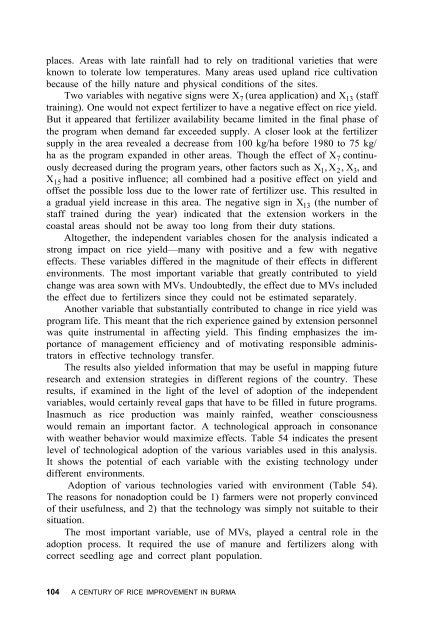A century of rice improvement in Burma - IRRI books - International ...
A century of rice improvement in Burma - IRRI books - International ...
A century of rice improvement in Burma - IRRI books - International ...
- No tags were found...
Create successful ePaper yourself
Turn your PDF publications into a flip-book with our unique Google optimized e-Paper software.
places. Areas with late ra<strong>in</strong>fall had to rely on traditional varieties that wereknown to tolerate low temperatures. Many areas used upland <strong>rice</strong> cultivationbecause <strong>of</strong> the hilly nature and physical conditions <strong>of</strong> the sites.Two variables with negative signs were X 7 (urea application) and X 13 (stafftra<strong>in</strong><strong>in</strong>g). One would not expect fertilizer to have a negative effect on <strong>rice</strong> yield.But it appeared that fertilizer availability became limited <strong>in</strong> the f<strong>in</strong>al phase <strong>of</strong>the program when demand far exceeded supply. A closer look at the fertilizersupply <strong>in</strong> the area revealed a decrease from 100 kg/ha before 1980 to 75 kg/ha as the program expanded <strong>in</strong> other areas. Though the effect <strong>of</strong> X 7 cont<strong>in</strong>uouslydecreased dur<strong>in</strong>g the program years, other factors such as X 1 , X 2 , X 3 , andX 15 had a positive <strong>in</strong>fluence; all comb<strong>in</strong>ed had a positive effect on yield and<strong>of</strong>fset the possible loss due to the lower rate <strong>of</strong> fertilizer use. This resulted <strong>in</strong>a gradual yield <strong>in</strong>crease <strong>in</strong> this area. The negative sign <strong>in</strong> X 13 (the number <strong>of</strong>staff tra<strong>in</strong>ed dur<strong>in</strong>g the year) <strong>in</strong>dicated that the extension workers <strong>in</strong> thecoastal areas should not be away too long from their duty stations.Altogether, the <strong>in</strong>dependent variables chosen for the analysis <strong>in</strong>dicated astrong impact on <strong>rice</strong> yield—many with positive and a few with negativeeffects. These variables differed <strong>in</strong> the magnitude <strong>of</strong> their effects <strong>in</strong> differentenvironments. The most important variable that greatly contributed to yieldchange was area sown with MVs. Undoubtedly, the effect due to MVs <strong>in</strong>cludedthe effect due to fertilizers s<strong>in</strong>ce they could not be estimated separately.Another variable that substantially contributed to change <strong>in</strong> <strong>rice</strong> yield wasprogram life. This meant that the rich experience ga<strong>in</strong>ed by extension personnelwas quite <strong>in</strong>strumental <strong>in</strong> affect<strong>in</strong>g yield. This f<strong>in</strong>d<strong>in</strong>g emphasizes the importance<strong>of</strong> management efficiency and <strong>of</strong> motivat<strong>in</strong>g responsible adm<strong>in</strong>istrators<strong>in</strong> effective technology transfer.The results also yielded <strong>in</strong>formation that may be useful <strong>in</strong> mapp<strong>in</strong>g futureresearch and extension strategies <strong>in</strong> different regions <strong>of</strong> the country. Theseresults, if exam<strong>in</strong>ed <strong>in</strong> the light <strong>of</strong> the level <strong>of</strong> adoption <strong>of</strong> the <strong>in</strong>dependentvariables, would certa<strong>in</strong>ly reveal gaps that have to be filled <strong>in</strong> future programs.Inasmuch as <strong>rice</strong> production was ma<strong>in</strong>ly ra<strong>in</strong>fed, weather consciousnesswould rema<strong>in</strong> an important factor. A technological approach <strong>in</strong> consonancewith weather behavior would maximize effects. Table 54 <strong>in</strong>dicates the presentlevel <strong>of</strong> technological adoption <strong>of</strong> the various variables used <strong>in</strong> this analysis.It shows the potential <strong>of</strong> each variable with the exist<strong>in</strong>g technology underdifferent environments.Adoption <strong>of</strong> various technologies varied with environment (Table 54).The reasons for nonadoption could be 1) farmers were not properly conv<strong>in</strong>ced<strong>of</strong> their usefulness, and 2) that the technology was simply not suitable to theirsituation.The most important variable, use <strong>of</strong> MVs, played a central role <strong>in</strong> theadoption process. It required the use <strong>of</strong> manure and fertilizers along withcorrect seedl<strong>in</strong>g age and correct plant population.104 A CENTURY OF RICE IMPROVEMENT IN BURMA

















